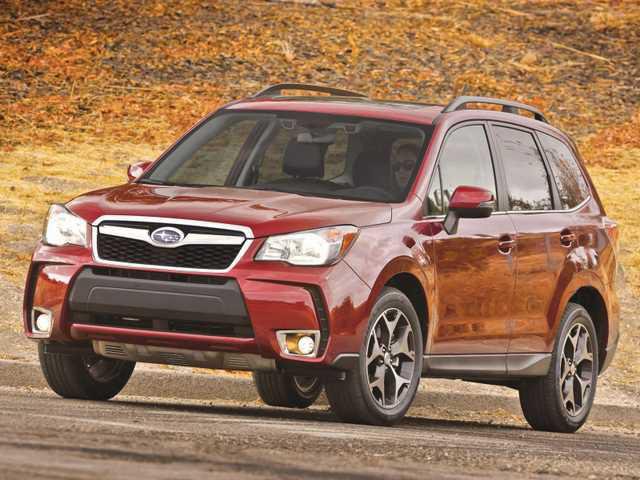Never has an “evolutionary” redesign been so revolutionary.
The 2014 Subaru Forester is a ground-up re-engineering with familiar styling and about the same exterior dimensions. It’s what is inside and under the skin that shows the strengths of this independent Japanese brand.
The Forester goes farther upscale with more luxury-class extras and farther afield with a more advanced all-wheel drive system. The redesign debuts a new 250-horsepower, turbocharged 2.0-liter four-cylinder engine -- still with the horizontally opposed pistons.
Sold in four trim levels, starting prices range from $22,820 to almost $34,000, including the $825 freight charge from Japan. The top-line 2.0T Touring is rich in driver-assist technologies and amenities such as keyless entry, push-button ignition and power tailgate.
The new architecture has a slightly longer (0.9-inch) wheelbase, now 103.9 inches. The exterior footprint is about the same (1.4 inches longer and wider by a half inch), but there was dedicated carving inside for much more room.
For a compact-class vehicle, there is oversized space. The front seats have 40 inches of headroom -- with the moonroof -- and 43 inches of legroom. And the 10-way power driver seat will raise even the shortest driver into position.
In back, there is full-size sedan legroom of 41.7 inches, a lower center tunnel and shorter front console, all of which makes better accommodations for three-across seating in back.
Base models use a 170-horsepower, 2.5-liter, non-turbo four-cylinder with six-speed manual transmission. The power is adequate but the transmission is geared for dutiful, fuel-saving performance, with ratings of 24 mpg city and 32 mpg highway.
There’s a more engaging spirit with the turbocharged 2.0-liter and the stepped continuously variable transmission ($1,000), with steering-wheel shifters. In manual-shift mode it mimics six shift points and in uplevel models there are steps for eight gears.
The 2.0XT has mileage of 23/28. I was getting a combined reading of 26.1 mpg and a bit higher without trying to conserve. EPA says combined is 25 mpg.
Getting max fuel economy is an elusive skill for many drivers, but Subaru has a trick that shows the relationship of accelerator angle and turbo force.
A page in the touchscreen readout has a three-image graphic that shows percent of acceleration, turbo boost and the engine temperature. In the same frame is the average fuel economy. “Eco meters” are becoming more common, but Subaru demonstrates how force on the gas pedal boosts the turbo, which affects mileage.
There is a simple, sturdy likability to the Forester. There are no gimmicks to design or function. What is there is intended to make life easier for the user. Sightlines are good at all angles, but the rearview camera screen is too small to be much help during the day; at night the image is bold. There is generous space in the various storage areas, in the doors, the (locking) glove box and console. There’s a good electronic-device charging cubby just ahead of the shifter. And the turning circle is trim at 34.8 feet
The 2.0XT Touring ($38,220 as tested) includes all the driver-assist technologies, which function without intrusion or annoyance. Subaru’s EyeSight system is unique in that it uses a stereo camera system, rather than radar, to watch the road ahead. The system links adaptive cruise control, pre-collision braking and vehicle lane departure warning. It becomes the driver’s defensive driving coach and keeps the focus from being distracted.
The cabin is well soundproofed, and the ride quality is comfortably firm. The ride height is just tall enough to see above the sea of traffic, which gives a sense of control to the driver.
There is good, durable quality to the materials and assembly. Even the perforated leather-trimmed upholstery is appealing, but it’s not so pretentious as to prevent owners from getting their Forester muddy and loading it with gear.
New safety features for all models include anti-whiplash front seats and a driver’s knee air bag.
The back seats have a 60/40 fold to expand cargo capacity but the space is not flat, as for car camping. The cargo area is generous at 31.4 cubic feet behind the back seat, with some basement storage in the cargo area. The opening is 43 inches wide and 33 inches tall with almost six feet of length for loading bikes and gear.
The all-wheel drive system was enhanced with X-Mode and Hill Descent Control. The “active” AWD system monitors engine, transmission shift pattern, braking, stability control and more to fine tune front and rear clutching force for better wheel control on slippery surfaces and steep inclines.
The Forester will appeal to families and adventure seekers -- now with a little more style and finesse for all.
Subaru Forester: A revolution in evolution


